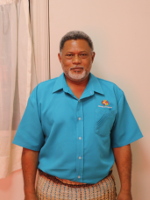Ministry of Fisheries, Tonga
Siolaa Malimali is a Fisheries Scientist at the Tonga Ministry of Fisheries, where he leads and coordinates the science activities within the Ministry of Fisheries in Tonga. After more than 20 years working at various at the fisheries sector he was appointed to head the Fisheries Science division of the Ministry of Fisheries in 2012 to date.
He played a key roles in leading the Special Management Areas (SMAs), an approach to better manage the fisheries under the community based fisheries and ecosystem management in Tonga. He also coordinates and involved with coral reefs research in relation to resource assessment such as seacucumber, marine habitats survey, community-based fisheries management, known as Special Management Areas (SMAs).
Historically Tonga’s coral reefs have been largely understudied, with little information on their overall status. As a result of few coral reefs works in Tonga suggested a poor and unhealthy coral status throughout Tonga. In 2016-2018 ecological surveys of reef condition were conducted at 300 sites across the country as part of Patrick Smallhorn-West’s PhD research, supported by the Tongan Ministry of Fisheries. Live coral cover increased from north to south. Mean live coral cover in Vava’u was seven percent, the lowest in the country, with widespread evidence of damage from cyclones, bleaching and poor water quality. Large urchin barrens with 0 % live coral cover were observed over large areas near the mouth of the estuarine lagoons. Average coral cover in Ha’apai was 21%, and 25 % in Tongatapu. Within Ha’apai the northern islands (Muitoa to Uiha) had widespread evidence of recent large-scale bleaching along the sheltered, western sides of the islands. The exposed southern islands of Ha’apai (Nomuka, Mango and Fonoi) had very high coral cover and were some of the healthiest reefs in the country. Coral cover in the Tongatapu lagoon, adjacent to the capital was high. However near the mouth of the Fanga’uta lagoon large urchin barrens and 0 % live coral cover was also observed.
These surveys found two broad and consistent patterns in the health of Tonga’s coral reefs. First, large coral bleaching events have likely occurred in areas with low exposure to flushing by cool, oceanic waters (e.g. sheltered areas of Vava’u and Ha’apai). This is exacerbated in Vava’u and minimized Tongatapu by a 2o C temperature difference which has protected the reefs of Tongatapu. Secondly, poor water quality flowing from the lagoons of Vava’u and Tongatapu (e.g. Fanga’uta) have resulted in widespread sea urchin barrens and decimated reefs, often with 0 % live coral cover. Bleaching conditions are directly associated with climate change and therefore action is needed on an international level. However, local action to improve water quality at the lagoon mouths may increase local resilience in the short-term.



